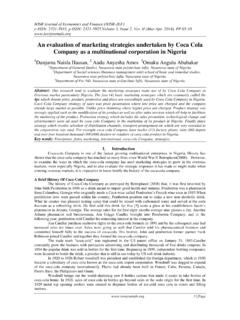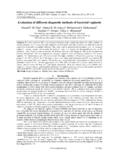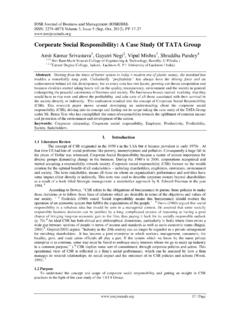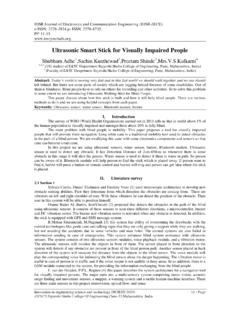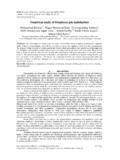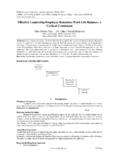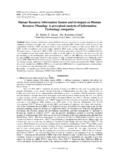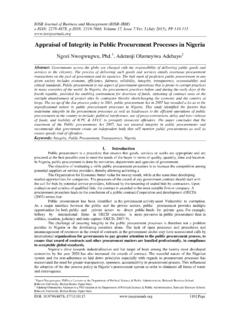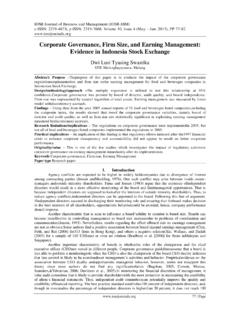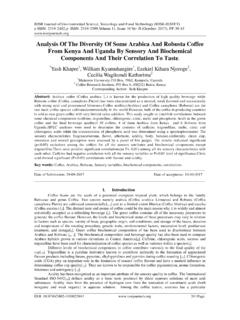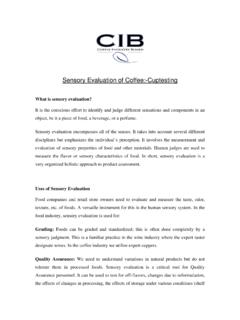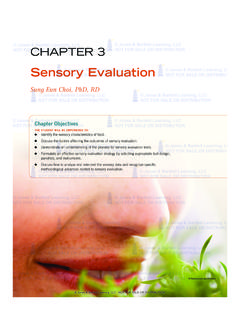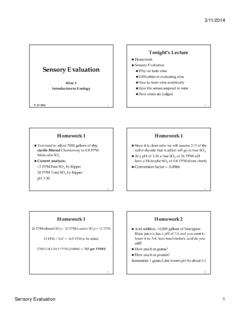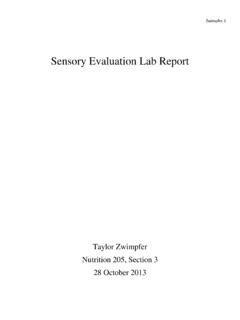Transcription of Effect of Different Fermentation Methods on ...
1 IOSR Journal of Environmental Science, Toxicology and Food Technology (IOSR-JESTFT) e-ISSN: 2319-2402,p- ISSN: 11, Issue 6 Ver. II (June. 2017), PP 31-36 DOI: 31 | Page Effect of Different Fermentation Methods on Physicochemical Composition and sensory Quality of coffee (Coffea arabica) Kinyua Agnes Wamuyu1, Kipkorrir K. Richard1, Mugendi W. Beatrice1, Kathurima Cecilia2 1 Institute of Food Bioresources and Technology, Dedan Kimathi University of Technology Nyeri, Kenya. 2 coffee Research Foundation, Ruiru, Kenya. Abstract: Fermentation of coffee beans is primarily done to remove mucilage and can be done using two Methods ; dry and wet Fermentation Methods . This research aimed at determining the Effect of Different Fermentation Methods on physicochemical composition and the sensory quality of coffee . coffee cherries were pulped and subjected to natural Fermentation Methods in Different Fermentation containers; plastic bucket, sack and cement tank.
2 After Fermentation , the parchment were washed and dried. The green coffee beans were evaluated for physicochemical composition and sensory attributes. The results showed that Different Fermentation Methods did not have significant variations in most of the physico-chemical parameters analysed. However, significant variations were observed in the levels of pH with the wet fermented coffee samples showing lower levels as compared to dry fermented samples. sensory evaluation results showed that wet fermented coffee samples had better colour of green beans, least silver skin discoloration and overall quality compared to dry fermented coffee samples. There were no significant differences in the body, acidity, colour, flavour and overall class among the coffee samples fermented using Different containers. Hence Different containers used during Fermentation do not affect coffee quality and processors can adopt materials that are cheaper to reduce expenses during coffee processing.
3 Key Words: Arabica coffee , Fermentation Methods , physicochemical composition, cup quality I. Introduction In Kenya, coffee is largely processed by wet method. The stages included during wet processing of coffee include; harvesting, sorting, removal of pulp, Fermentation followed by washing, grading drying and finally storage[1]. coffee is fermented to ease the removal of a layer of mucilage surrounding the bean, after which it is washed and dried. During Fermentation the mucilage is degraded by natural enzymes in coffee fruits and the growth of microorganisms[2]. Chemical changes that occur during Fermentation are pectin degradation by pectinase enzymes and breakdown of sugars in the mucilage[3]. Fermentation is concluded when the mucilage is easily detached by washing. Apart from mucilage removal Fermentation also has impact on chemical composition of coffee bean and resulting cup quality.
4 Microbial Fermentation yields Different flavor materials by breaking down the carbohydrates in the coffee mucilage and thus the superior aroma characteristics of wet-processed coffees[4]. The processing method used in production of green coffee affects the chemical composition and cup quality of the coffee beans[5]. The better cup quality produced from naturally fermented coffee is mainly attributed to the involvement of microorganisms in the degradation process of mucilage. These microorganisms produce volatile flavoring compounds which can diffuse in to the beans [6]. A literature report by Nigam and Singh[9] noted that free amino acids could be released in the bean following the degradation of proteins during the Fermentation process in coffee . These chemical compounds if present in small amounts may produce significant changes in the organoleptic quality of the brew [8].
5 A small portion of the acetic acid produced during Fermentation remains in the bean and free amino acids are produced in the bean. This therefore changes the final concentration of acetic acid and free amino acids in green beans which plays an important role in the perceived acidity and aroma formation of coffee produced [9]. Wet Fermentation , involves water being added to submerge the coffee parchment in Fermentation tank. For dry Fermentation , the coffee parchment fermented in a tank without addition of the water [10]. In Kenya, coffee parchment Fermentation is commonly done under dry or wet Fermentation Methods . Wet Fermentation method is commonly used when conditions are too hot and Fermentation conditions need to be controlled. Similarly coffee processors may utilize Different equipment during the Fermentation of coffee parchment [11]. This variations in the method and equipment used may cause variations in several parameters which could influence the final coffee quality.
6 However, there is limited information on the Effect of Different Fermentation Methods and materials used on the chemical composition and the final cup quality. This research aimed at Effect Of Different Fermentation Methods On Physicochemical Composition And sensory Quality Of DOI: 32 | Page determining the effects of Different Fermentation Methods and materials used on physicochemical composition and cup quality of coffee . II. Methods And Methods Collection and Treatment coffee cherries of Ruiru 11 cultivar was obtained from Dedan Kimathi University of Technology coffee farm, located in Nyeri County, Kenya. The ripe cherries were harvested from coffee plants grown in the same block by selective hand picking method to obtain uniform ripe cherries. The cherries were pulped and then subjected to four Different treatments which included dry Fermentation of coffee parchment in a sack, dry Fermentation in a plastic bucket, dry Fermentation in a cement tank and wet Fermentation in a plastic bucket.
7 For dry Fermentation in a plastic bucket, perforations at the bottom of the container allowed the excess water to drain while for wet Fermentation the parchment was submerged in water in a plastic bucket. A control sample was also prepared by Fermentation of coffee parchment in a cement tank by the dry method. The end of Fermentation was assessed by rubbing a few beans of the fermenting coffee in the hand to check whether they felt gritty and can easily be washed. After Fermentation the coffee parchment was thoroughly washed to remove the degraded mucilage and then dried to reduce moisture content to a level of to 10%[12]. Physicochemical Composition Preparation of Green Beans for Chemical Analysis The parchment were hulled and ground to obtain fine powder of particle size for analysis of physicochemical components including; crude protein, titratable acidity, pH, sucrose, caffeine, chlorogenic acids and trigonelline.
8 Determination ofCrude Protein Crude protein was determined using Kjedhal method as described in [13]. The Protein % was calculated by multiplying nitrogen value obtained by protein factor ( ). Determination Titratable Acidity Total acidity in the coffee samples was determined by adding 10 g of the coffee sample in a conical flask with 75 ml 80% alcohol. Agitation was done using a shaker for 16 hours followed by filtration. Ten ml of the filtrate was diluted to 100 ml followed by titration with Sodium hydroxide using phenolphthalein as an indicator [14]. Determination of pH The pH of coffee samples was determined using the method as described by [15].Three grams of ground coffee were added to 50ml hot water. The extract was cooled to room temperature and pH measured using a pH meter. Determination of Sucrose Content Sucrose was determined using High Performance Liquid Chromatography (HPLC) analysis as described by [5].
9 In sample preparation, of the sample was added to a flask containing 50ml 96 % ethanol. The mixture was refluxed for one hour, then ultrasonicated for six minutes. This was followed by cooling and filtration using a Whatman filter paper filtrate obtained was evaporated to dryness using rotor vapors. It was then reconstituted with10 ml mobile phase containing acetonitrile: water 80:20 and filtered using micro filter ( m). A sample of 20 m was injected into HPLC fitted with a refractive index. Determination ofCaffeine Content Extraction and purification of caffeine was done as described by [16]. Five (5) grams of the ground coffee powder was weighed in a 250 ml Erlenmeyer flask before adding grams of magnesium oxide and 200 ml of double distilled water. The mixture was refluxed for 25 minutes and then left to cool. It was then filtered under vacuum on celite and the filtrate recovered in a 250 ml flask topping up the volume with distilled water.
10 Twenty (20) ml of this preparation was then pipetted into 100 ml flask adjusting to volume with mobile phase consisting of 35% v/v methanol, 65% v/v distilled water and v/v glacial acetic acid. The extracts were then filtered using m micro filters. A sample volume of 20 l was injected into HPLC with pulsed diode array (PDA) detector set at 278 nm. Peak areas were used for calculating the concentration of caffeine. Determination of Chlorogenic Acid Content The coffee samples were prepared for HPLC analysis according to the method described by [17]. Two grams of each ground coffee sample were weighed accurately in 250 ml beakers and 100 ml distilled water was added to each sample. The mixture was boiled for 5 minutes while stirring, and then cooled. Subsequently, the solution was filtered using m filter paper. The clear filtrate with some dilution was used for the HPLC analysis with detector, pulsed diode array set at 324 nm.
